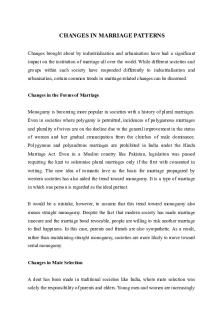Changes IN Marriage Patterns PDF

| Title | Changes IN Marriage Patterns |
|---|---|
| Course | Introduction To Sociology |
| Institution | Aligarh Muslim University |
| Pages | 4 |
| File Size | 75.8 KB |
| File Type | |
| Total Downloads | 430 |
| Total Views | 994 |
Summary
CHANGES IN MARRIAGE PATTERNSChanges brought about by industrialisation and urbanisation have had a significant impact on the institution of marriage all over the world. While different societies and groups within each society have responded differently to industrialisation and urbanisation, certain ...
Description
CHANGES IN MARRIAGE PATTERNS Changes brought about by industrialisation and urbanisation have had a significant impact on the institution of marriage all over the world. While different societies and groups within each society have responded differently to industrialisation and urbanisation, certain common trends in marriage-related changes can be discerned.
Changes in the Forms of Marriage
Monogamy is becoming more popular in societies with a history of plural marriages. Even in societies where polygamy is permitted, incidences of polygamous marriages and plurality of wives are on the decline due to the general improvement in the status of women and her gradual emancipation from the clutches of male dominance. Polygynous and polyandrous marriages are prohibited in India under the Hindu Marriage Act. Even in a Muslim country like Pakistan, legislation was passed requiring the kazi to solemnise plural marriages only if the first wife consented in writing. The new idea of romantic love as the basis for marriage propagated by western societies has also aided the trend toward monogamy. It is a type of marriage in which one person is regarded as the ideal partner.
It would be a mistake, however, to assume that this trend toward monogamy also means straight monogamy. Despite the fact that modern society has made marriage insecure and the marriage bond revocable, people are willing to risk another marriage to find happiness. In this case, parents and friends are also sympathetic. As a result, rather than maintaining straight monogamy, societies are more likely to move toward serial monogamy.
Changes in Mate Selection
A dent has been made in traditional societies like India, where mate selection was solely the responsibility of parents and elders. Young men and women are increasingly
being given a say in the selection of their mates. From a position where they had no say in who they married, they have now reached a point where they are consulted and their consent is sought. Sons and daughters in urban middle-class families have even come to enjoy the right to veto marriage proposals proposed by others. Parents in more advanced and enlightened urban families are now providing opportunities for their children to meet potential mates. "Dating" a practise in which a boy and a girl meet in a college or university to get to know each other and enjoy themselves with relative freedom, is a phenomenon that can be seen in India's predominantly metropolitan cities' colleges and universities. It is yet another imitation of Western society, this time as a result of people being exposed to Western culture to a much greater extent than before.
Mate selection through newspaper advertisements has become quite popular among India's urban middle classes, and the most recent development is the reported use of computers to bring potentially compatible mates together. Changes in Age of Marriage
In India, where child marriages were traditionally prescribed, preferred, and encouraged, various efforts by social reformers were made to put an end to the practise; as a result, the Child Marriage Restraint Act, also known as the Sarda Act, was passed in 1939. Despite the impact of modern industrialisation and urbanisation, early marriage persists, particularly among rural people. There was also a strong tendency in urban areas to marry off a daughter as soon as possible. However, as the number of girls enrolled in schools and colleges grows, as does their desire to work, and as the vast majority of boys struggle to "settle down7in life," the age of marriage is inevitably being pushed up. Furthermore, as part of its population policy, the government has established an 18-year-old minimum age for girls and a 20-year-old minimum age for boys for marriage. However, in urban areas, marriages are increasingly taking place after the prescribed minimum ages have passed.
Changes in Marriage Rituals and Customs
India's recent changes have created a paradoxical situation. With the advancement of technology and science, it was expected that a secular-scientific perspective would emerge, and as a result, non-essential rituals and customs have always pleaded for the avoidance of wasteful expenditures on meaningless rituals and customs. However, contrary to the expectations of enlightened people, marriages in India are becoming more traditional in terms of the ritual-custom complex. Many rituals and customs that appeared to have weakened soon after independence are now being revived. Affluence plays a role in this revival to some extent. Many people in society have a lot of money to spend on weddings, and the less fortunate have a tendency to follow in the footsteps of the wealthy.
Changes in Marriage: Goals and Stability In traditional societies, procreation was the most important function of marriage, as previously stated. A large number of children bestowed higher status on parents in all communities, and Hindu sons were especially desired. As a result, one of the most cherished goals of marriage was to have a large family, and the blessings bestowed upon the bridal couple included wishes for several children.
However, modern life has made having a large family difficult; in fact, even families with three or four children are being marginalised.
Several developing countries are aware of the problems that rapidly growing populations can cause and are committed to promoting the small-family norm. Many of these have declared their official policy of limiting family size. India was the first country to implement a national family planning programme. Citizens in democratic Asian and African countries are being educated to understand and accept the benefits of limited procreation through vigorous educational efforts.
China has also implemented strict population control measures, including disincentives and penalties for couples who do not limit procreation. All of these efforts are slowly changing people's values in India and other countries. It is becoming clear that having about two healthy and well-cared-for children is preferable to having a large number of children who cannot be adequately fed, clothed, or looked after.
As procreation, and with it the role of parenting, becomes less important, other aspects of marriage, such as companionship and emotional support from a spouse and children, become more important. In fact, today's young people marry for the sake of happiness and personal fulfilment.
In the future, the conditions that cause marital instability are likely to worsen rather than improve. Our perspectives, values, and ideals about marriage are also changing. So, what does marriage's future hold? Predictions about social life are difficult and dangerous. However, it appears unlikely that marriage, as a major event in one's personal and social life, will ever be abandoned. If the evidence from Western societies is any indication, high divorce rates will not automatically deter people from marrying. Regardless of marital insecurity, an individual's search for happiness in marriage will continue....
Similar Free PDFs

Changes IN Marriage Patterns
- 4 Pages

Marriage in British India
- 20 Pages

Muslim Marriage IN India
- 6 Pages

Marriage Analysis in Shiloh
- 5 Pages

Changes in Matter
- 4 Pages

Changes in the land
- 2 Pages

Statement of Changes in Equity
- 2 Pages

Design Patterns in Java Tutorial
- 168 Pages

Session 4 Changes in PPC
- 6 Pages

Age Changes in Dental Tissue
- 8 Pages

5. Changes in short vowels
- 1 Pages

Statement of changes in equity
- 6 Pages

Chemical Changes Sehand IN COPY
- 13 Pages

Arranging a marriage in India
- 5 Pages

Changes in the land 1
- 24 Pages
Popular Institutions
- Tinajero National High School - Annex
- Politeknik Caltex Riau
- Yokohama City University
- SGT University
- University of Al-Qadisiyah
- Divine Word College of Vigan
- Techniek College Rotterdam
- Universidade de Santiago
- Universiti Teknologi MARA Cawangan Johor Kampus Pasir Gudang
- Poltekkes Kemenkes Yogyakarta
- Baguio City National High School
- Colegio san marcos
- preparatoria uno
- Centro de Bachillerato Tecnológico Industrial y de Servicios No. 107
- Dalian Maritime University
- Quang Trung Secondary School
- Colegio Tecnológico en Informática
- Corporación Regional de Educación Superior
- Grupo CEDVA
- Dar Al Uloom University
- Centro de Estudios Preuniversitarios de la Universidad Nacional de Ingeniería
- 上智大学
- Aakash International School, Nuna Majara
- San Felipe Neri Catholic School
- Kang Chiao International School - New Taipei City
- Misamis Occidental National High School
- Institución Educativa Escuela Normal Juan Ladrilleros
- Kolehiyo ng Pantukan
- Batanes State College
- Instituto Continental
- Sekolah Menengah Kejuruan Kesehatan Kaltara (Tarakan)
- Colegio de La Inmaculada Concepcion - Cebu
